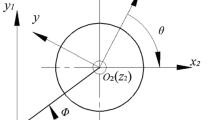Abstract
The prediction of cutting forces is important for the planning and optimization of machining process in order to reduce machining damage. Helical milling is a kind of hole-machining technique with a milling tool feeding on a helical path into the workpiece, and thus, both the periphery cutting edges and the bottom cutting edges all participated in the machining process. In order to investigate the characteristics of discontinuous milling resulting in the time varying undeformed chip thickness and cutting forces direction, this paper establishes a novel analytic cutting force model of the helical milling based on the helical milling principle. Dynamic cutting forces are measured and analyzed under different cutting parameters for the titanium alloy (Ti–6Al–4V). Cutting force coefficients are identified and discussed based on the experimental test. Analytical model prediction is compared with experiment testing. It is noted that the analytical results are in good agreement with the experimental data; thus, the established cutting force model can be utilized as an effective tool to predict the change of cutting forces in helical milling process under different cutting conditions.
Similar content being viewed by others
References
Qin XD, Chen SM, Liu WC (2009) Development and application of helical milling technology in the aviation manufacturing and assembly industry. Aeronaut Manuf Technol (in Chinese) 6:58–60
Ni WY (2007) Orbital drilling of aerospace materials. Aerospace Manufacturing and Automated Fastening Conference and Exhibition 01:3814–3822
Denkena B, Boehnke D, Dege JH (2008) Helical milling of CFRP–titanium layer compounds. CIRP J Manuf Sci Technol 1:64–69
Iyer R, Koshy P, Ng E (2007) Helical milling: an enabling technology for hard machining precision holes in AISI D2 tool steel. Int J Mach Tools Manuf 47:205–210
Sasahara H, Kawasaki M, Tsutsumi M (2008) Helical feed milling with MQL for boring of aluminum alloy. J Adv Mech Des Syst Manuf 2(6):1030–1040
Brinksmeier E, Fangmann S, Meyer I (2008) Orbital drilling kinematics. Prod Eng Res Devel 2:277–283
Qin XD, Hua S, Ji XL, Liu WC, Chen SM (2010) Research on the surface roughness model for helical milling of die-steel based on response surface methodology. Key Eng Mater 431–432:346–350
Qin XD, Wang Q, Wang HY (2011) Dynamic analysis of helical milling unit based on virtual machine tool. Adv Mater Res 188:463–468
Zhang L, Zheng L (2005) Prediction of cutting forces in end milling of pockets. Int J Adv Manuf Technol 25(3):281–287
Budak E, Altintas Y, Armarego EJA (1996) Prediction of milling force coefficients from orthogonal cutting data. J Manuf Sci Eng Trans ASME 118:216–224
Kardes N, Altintas Y (2007) Mechanics and dynamics of the circular milling process. J Manuf Sci Eng Trans ASME 129(2):21–31
Zhang L, Zheng L (2004) Prediction of cutting forces in milling of circular corner profiles. Int J Mach Tools Manuf 44:225–235
Li ZQ, Liu Q (2010) Modeling and simulation of chatter stability for circular milling. J Mech Eng (in Chinese) 46(7):181–186
Wei ZC, Wang MJ, Han XG (2010) Cutting force prediction in generalized pocket machining. Int J Adv Manuf Technol 50:449–458
Budak E (2006) Analytical models for high performance milling. Part I: cutting forces, structural deformations and tolerance integrity. Int J Mach Tools Manuf 46:1478–1488
Altintas Y (2000) Manufacturing automation——metal cutting mechanics, machine tool vibrations, and CNC design. Cambridge University Press, UK
Gradisek J, Kalveram M, Weinert K (2004) Mechanistic identification of specific force coefficients for a general end mill. Int J Mach Tools Manuf 44:401–414
Gonzalo O, Beristain J, Jauregi H, Sanz C (2010) A method for the identification of the specific force coefficients for mechanistic milling simulation. Int J Mach Tools Manuf 50:765–774
Gonzalo O, Jauregi H, Uriarte G, Lopez de Lacalle LN (2009) Prediction of specific force coefficients from a FEM cutting model. Int J Adv Manuf Technol 43:348–356
Araujo AC, Silveira JL, Jun MBJ (2006) A model for thread milling cutting forces. Int J Mach Tools Manuf 46:2057–2065
Altintas Y, Spence A (1991) End milling force algorithms for CAD systems. Ann CIRP 40(1):31–34
Author information
Authors and Affiliations
Corresponding author
Rights and permissions
About this article
Cite this article
Wang, H., Qin, X., Ren, C. et al. Prediction of cutting forces in helical milling process. Int J Adv Manuf Technol 58, 849–859 (2012). https://doi.org/10.1007/s00170-011-3435-y
Received:
Accepted:
Published:
Issue Date:
DOI: https://doi.org/10.1007/s00170-011-3435-y




